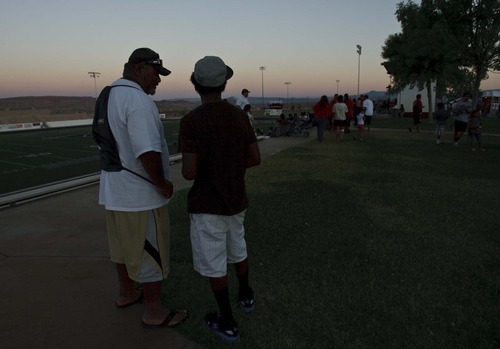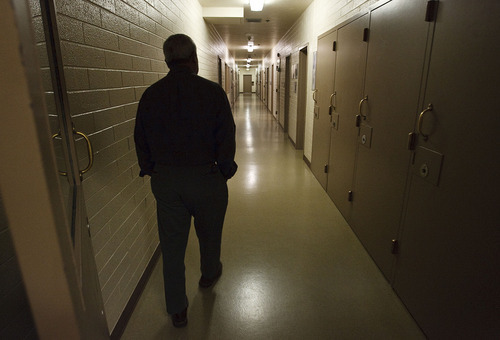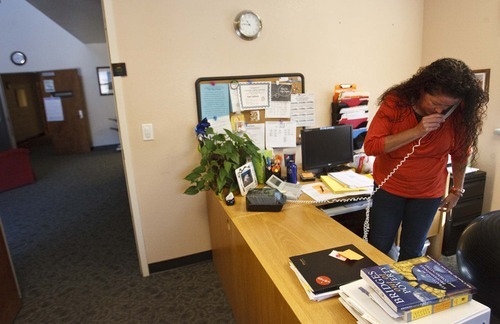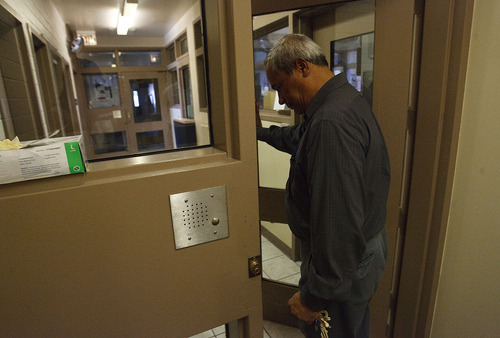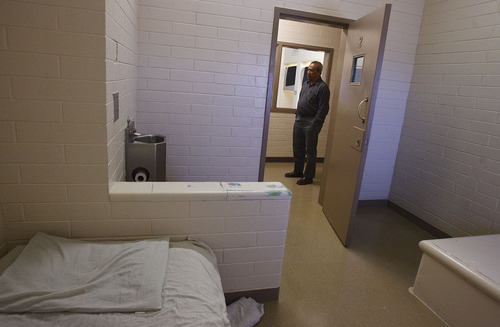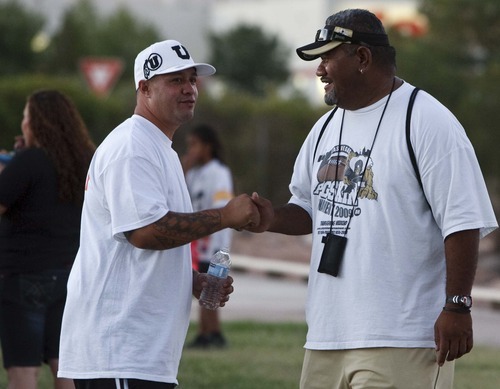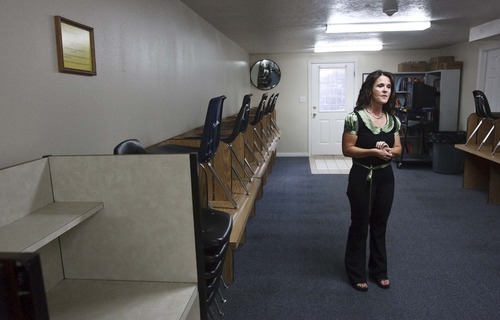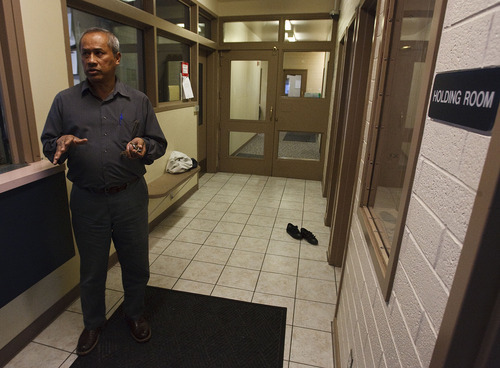This is an archived article that was published on sltrib.com in 2012, and information in the article may be outdated. It is provided only for personal research purposes and may not be reprinted.
Enoch, Iron County • It's easy to tell there's a lot of love in Mary Fletcher's home, but like most parents, Fletcher has faced some challenges in raising her family.
Over the decades, the 66-year-old, who has had no natural children of her own, adopted 12 American-Indian children from the foster care system. Some were born with fetal alcohol syndrome and suffer from developmental disabilities or emotional issues.
She admits there were days with one child when those emotional issues boiled over into violent outbursts that were beyond her ability to cope. So she turned to the experts at Iron County Youth Center, a state-funded juvenile justice program, to help her family and her son, who is now an adult. She expects she'll use the program in the future with her other children.
"[ICYC] has been a total blessing," she said. "It's really wonderful when you're in a crisis to turn your child over to someone who will make a difference. They should have [programs like] that all over the country. They help children with their emotions that they don't know how to deal with."
But now that program and a number of other juvenile-justice programs across the state are in jeopardy of closing or offering fewer services because of about $3.2 million in legislative budget cuts.
The cuts follow a federal government decision to restructure its Medicaid programs. The state no longer is reimbursed for youths housed overnight. That translated into about a $27 million loss in funding, said Sen. Lyle Hillyard, R-Logan. He said the state can no longer afford to fund all the juvenile-justice programs it once did and still fund other areas of government like public education.
"We, as a system, are operating in a crisis mode. That's the scary thing," said Jill McKinlay, a Utah juvenile-justice program administrator who oversees the ICYC.
But those cuts are expected to come at a steep cost and possibly a larger price tag for Utahns down the road. Experts predict the number of state Division of Child and Family Services (DCFS) cases and juvenile detention referrals will grow because many of the programs affected by the cuts are for early intervention — designed to keep youths out of the system.
The cuts seem to be disproportionately affecting Utah's residents who live outside Salt Lake and Utah counties, officials say.
"Each child deserves the kind of services equal to Salt Lake," said Robert Johnson, a child welfare administrator for DCFS. "The rural areas throughout our region took a bit of a hit."
Legislators managed to slap together some last-minute funding to keep most of the facilities operational, albeit on a limited basis through the start of 2013, but in many rural regions the cuts have left gaping holes.
"It's disheartening and tragic in so very many ways," said Gov. Gary Herbert's spokeswoman Ally Isom of the cuts. "We'd like to see it addressed in future budgets because if we don't assist many of these youth in their present situation, they often end up in the adult system and incur further social costs and greater family tragedy."
—
Juvenile experts alarmed • Parowan Police Chief Ken Carpenter still vividly remembers the day officers found a young man passed out along a roadway in the middle of winter, extremely intoxicated.
Police quickly determined the youth's parents were out of state, but instead of taking him to detention or DCFS, officers decided he'd be best served by the early-intervention program, Carpenter said. ICYC kept him safe until his parents could arrive.
"It gives us a place to take them where we know they're going to be safe," Carpenter said.
Other success stories across the state: temporarily housing children who were orphaned when their parents were killed in crashes; working with girls who were lured away by sexual predators; counseling out-of-control youths; providing support for victims of neglect and abuse; and reuniting runaways with their families.
For Carpenter's small department of four full-time officers, the center is a lifesaver — a place to take youths rather than tying up limited resources.
"[Without it] I either need to bring another officer in on overtime and basically pay him to be a baby sitter … or I don't have an officer to cover the other law enforcement needs of my community," Carpenter said. "That can have a pretty dramatic impact on my budget as far as overtime and how we handle juveniles."
He said if the state offers police officers no alternatives, departments will probably have to turn them over to state custody.
The possibility of more youths suddenly becoming wards of the state has juvenile-justice experts very concerned.
DCFS relies on the juvenile-justice youth services for temporary placement of children who must be removed from their homes. It can be difficult to find foster homes on short notice.
"We have to have some place for them to go," said Johnson. "Our contract providers aren't set up to do the 3 a.m. call."
If one receiving center is full or is closed due to cuts, DCFS staff will have to drive to the next closest center, potentially taking a youth more than five hours away from their home community and undermining the agency's efforts to provide as much stability as possible.
—
"We're in a war right now" • Alii Alo, an employee at the Washington County Youth Crisis Center, has spent the past decade building relationships with young men in St. George in an effort to keep them out of the justice system.
Many of the 50 to 60 youths he works with each week have unstable home lives, have opted to join gangs or have turned to drugs.
His message: "Don't give up; there's a better way. You just haven't been introduced to it."
He's organized street basketball games, provided resources to Job Corps, organized boxing matches to teach conflict resolution and encouraged youths to go to college — even helping one boy get a basketball scholarship. He also set up a poetry club and provides a safe environment for youths to do their homework at the Youth Crisis Center.
"We're in a war right now," Alo said. "All the drug dealers and gang recruiters are out here. We're losing the war. We're losing the kids."
The budget cuts, however, have eliminated Alo's outreach efforts.
Statewide, officials said they've seen sweeping impacts on youths, their families and even people who may not think the budget cuts directly impact them.
"This whole thing has turned into a bigger issue than we thought," said Ron Harrell, program director over the state's secure juvenile justice facilities. "It's impacting the court, the families. It's just impacting the community in different ways."
In Roy, the Weber Valley Detention Center is now operating at about half capacity with its number of beds cut from 34 to 16. That has police concerned about public safety. They're suddenly having to make a 30 minute drive down to Davis County's Farmington Bay Youth Center, the next closest correctional facility. If that facility is full, they have to drive another 30 minutes to Salt Lake City.
That means fewer police officers on the streets.
—
Impact on taxpayers • "It's a concern, said Ogden police Lt. Chad Ledford. "The taxpayers in Weber County and Ogden pay for police services and expect them to be on the street. The citizen has to wait longer [for us to respond], and it just becomes a domino effect."
It's also made it more difficult for parents, many of whom don't have reliable transportation, to visit their child when they're incarcerated 30 minutes away instead of 10. It may also mean two siblings may find themselves incarcerated in different counties.
"They still want their parents," said Kingi Tonga, who oversees the Weber Valley Detention Center. "There is obviously a very strong tie to the family, no matter what."
Utah court spokeswoman Nancy Volmer said officials are concerned about the lack of services and placements available for youths, the fact that the state has to place children in other counties and the burden it will place on parents who have to pick up and visit children.
"With the partial closure of some receiving centers in rural areas, delinquent youths will remain in police custody longer, which has a negative impact on youth, their families and on police who need to return to patrolling our community," she said.
In addition, the Weber County Sheriff's Office, which is responsible for transporting youths to juvenile-court proceedings in the 2nd District, said it's feeling the crunch. Already, the sheriff's office has to transport a number of children from Farmington to Ogden and back. They've asked courts to provide at least 72 hours notice before a youth is scheduled to appear, Chief Deputy Kevin Burton said.
Transporting youths from Davis to Weber counties is expected to cost local taxpayers up to $75,000 year, he said.
"It's unfortunate," Burton said. "Our contention is, it's a state function, and our state made a decision that imposes a burden to us on a county level."
For Fletcher, whose family benefited from the programs, the issue is plain. Legislators need to find a way to save the programs, even if that means cutting in other areas.
"ICYC really has helped me," she said. "It would really break my heart if they [close it]."
Twitter: @sltribjanelle —
The cuts, by the numbers
46 • Utah jobs eliminated
1 • Davis County Youth Services closed
16 • Number of beds at Weber Valley Detention Center (reduced from 34). When it closes March 1, an additional 23 jobs will be eliminated.
$350,000 • Cut to Genesis Youth Center in Salt Lake County —
What do these facilities do?
Youth service centers • Divert youths from the juvenile justice system. Provide immediate intervention by engaging and motivating youths and families to access resources and resolve conflict. The following services are available at most youth service facilities: crisis counseling; individual and family therapy; group therapy; education groups and support for parents and youths; referral to community agencies; assessment; and short-term voluntary residential placements.
Receiving centers • Provide a location for local law enforcement to take youths after arrest for status offenses or delinquent acts that do not meet Detention Admission Guidelines. Receiving center staff members work to find parents or guardians, evaluate the youth's immediate needs and refer them for services.
Detention centers • Short-term locked confinement for delinquent youths awaiting adjudication, placement or serving a sentence as ordered by a juvenile court judge. —
What happened?
Utah lost $27 million a year in Medicaid funding.
Role of Medicaid • When a youth enters either Juvenile Justice Services (JJS) or Division of Child and Family Services (DCFS) custody, the state becomes the guardian. Medicaid funds are used to help finance much of the residential care and related costs for youths.
What the feds decided • After July 1, 2010, they'd no longer pay nonmedical costs associated with residential care.
Impact of federal decision to Utah annually • Loss of $9 million to JJS, loss of $18 million to DCFS
Funding runs out • For two years, legislators have provided stopgap funding to help agencies adjust, but that funding ran out during the legislative session.
Source: Office of the Legislative Fiscal Analyst


